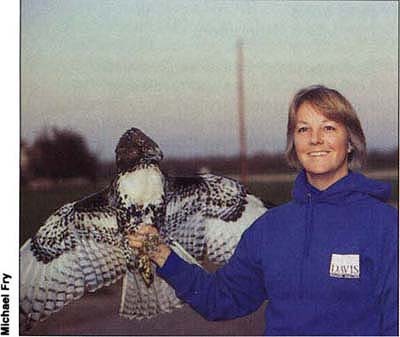All Issues
Minimizing the hazards of dormant sprays to wildlife
Publication Information
California Agriculture 49(3):4-5.
Published May 01, 1995
PDF | Citation | Permissions
Full text
Dormant insecticide sprays such as diazinon, chlorpyrifos and methidathion are an important part of the Integrated Pest Management (IPM) programs of California fruit and nut orchards. Spraying dormant trees with a mix of organophosphates (OP) and light oil during the winter kills harmful insects and mites when their natural enemies are absent, resulting in more biological control during the season. This practice has led to a 30% reduction of total OP use through out the year.
However, after finding that dormant sprays have drifted off site and exposed red-tailed hawks and other protected bird species to poisonous chemicals, California Department of Food and Agriculture (CDFA) requested studies of dormant sprays and their impact on the hawks.
Nancy Ottum and other scientists tracked red-tailed hawks and evaluated the health effects of their exposure to dormant sprays.
In response, a multidisciplinary team of UC Davis scientists — led by avian biologist Barry W. Wilson, analytical toxicologist James Seiber (now at University of Nevada, Reno), avian wildlife toxicologist Michael Fry, agricultural engineer William Steinke, IPM specialist Frank Zalom and hydrologist Mark Grismer — has been working to improve the efficiency of dormant sprays and to reduce their risks to wildlife.
The researchers have completed a 2-year study of hawks inhabiting a 50-square mile region near Ceres. They determined land use and pesticide application patterns and air concentrations of pesticides during dormant spraying at the Ceres site and tracked more than 40 hawks with radiotransmitters. In doing so, the scientists established that the birds' home ranges were usually less than one square mile and in regions where the pesticide was sprayed.
“Although no birds were recorded as dying from pesticide exposure during the study,” project coordinator Wilson says, “chemical and biochemical analyses showed that enough pesticides reached the hawks to be detected on their feet and in their excreta and to depress their blood cholinesterase. Enough data were obtained to derive an equation that indicated the relative contributions of the pesticides in the study to the reduction of blood cholinesterase levels.”
Blood cholinesterase levels are biomarkers of exposure to organophosphate and organocarbamate pesticides, Wilson explains, since they block similar enzymes in the central nervous system and junctions of nerves and muscles. Cholinesterase inhibition can lead to muscle weakness, salivation, and ultimately convulsions and death. Since scientists cannot sample brains, spinal cords or muscles without harming the subject, they substitute blood cholinesterase measurements. Blood cholinesterase measurements are required in California for all agricultural workers using the kinds of pesticides sprayed in orchards.
Two major routes of the hawks' exposure to the pesticides are through their feet or mouth. Laboratory studies of pigeons and American kestrels revealed that the plasma cholinesterase levels in the birds' blood took many days to recover when pesticides were applied to their feet, but recovered much faster from oral exposure. These lab and field studies suggest birds could accumulate these pesticides by flying from tree to tree, orchard to orchard during dormant spray season.
The sprayer study used a conventional fan blast sprayer and an experimental mast sprayer to apply a mixture of diazinon and Volk oil at different rates of active ingredient (ai) and finished volumes.
The researchers achieved peach twig borer control at rates as low as 1 pound ai per acre and 25 gallons per acre using a mast sprayer, and 2 pounds ai per acre and 100 gallons per acre using a conventional sprayer.
After direct spraying, they found pesticides on the feet of the caged pigeons used as surrogates to the hawks. “Cholinesterases in their blood and brains decreased in a dose-dependent manner,” Wilson says. In other words, the more spray, the lower the birds' cholinesterase levels.
The researchers concluded the best way to mitigate spray drift, its toxicity to wildlife and possibly to runoff is to reduce the amount applied. To date, the studies tend to support a recommendation that diazinon rates can be cut in half to 2 pounds per acre for lightly infested orchards, but the studies are continuing and now include studies of pesticide runoff. Wilson explains that IPM recommendations for sprays are based on several years of data because, as growers know, there are no “average” years for insects.
“Agricultural research needs to become more multidisciplinary to tackle the problems raised by the impact of agricultural practices, especially use of pesticides on the urban and wild environments,” says Wilson. “This project is a good example of how university scientists, UC farm advisors, the State of California, growers and agrichemical companies can work together on an important problem.”
In addition to the USDA Pesticide Impact Assessment Program, these studies have been supported by several commodity groups — Almond Board of California, California Prune Board, California Cling Peach Advisory Board — and a consortium of chemical companies including Ciba, Cheminova Agro, Machtashim Agan and Nichimen America.
Also collaborating on the studies were UC Cooperative Extension Fresno County farm advisor Rich Coviello, former Stanislaus County farm advisor Wes Asai, former graduate student Julie Yamamoto and UC Davis technicians John Henderson, Michael McChesney, Robert Siegal and Nancy Ottum.
-Editor





